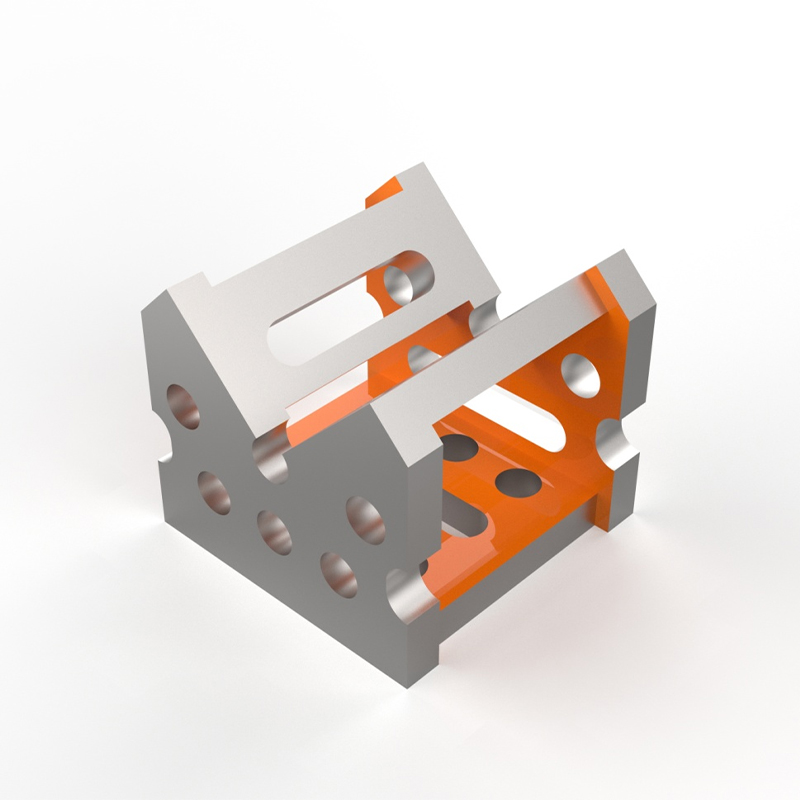ए कोण जडान ब्लक, प्रायः कुना कोष्ठक वा L-कोष्ठकको रूपमा उल्लेख गरिएको, एक आधारभूत हार्डवेयर घटक हो जुन दुई भागहरू जोड्न प्रयोग गरिन्छ, सामान्यतया 90-डिग्री कोणमा। यी कनेक्टरहरूले संरचनात्मक सुदृढीकरण, स्थिरता, र फर्निचर एसेम्बली र सेल्फिङ प्रणालीदेखि भारी-कर्तव्य औद्योगिक फ्रेमवर्क र निर्माण परियोजनाहरूमा विस्तृत एपहरूमा सटीक पङ्क्तिबद्धता प्रदान गर्दछ। तिनीहरूका प्रकारहरू, फाइदाहरू, र चयन मापदण्डहरू बुझ्न बलियो र भरपर्दो जडानहरू सुनिश्चित गर्न महत्त्वपूर्ण छ।
एक के हो कोण जडान ब्लक?
यसको मूल मा, एक कोण जडान ब्लक कठोर सामग्रीको टुक्रा हो, सामान्यतया धातु वा कहिलेकाहीँ भारी-कर्तव्य प्लास्टिक, एक कोणमा बनाइन्छ, सामान्यतया 90 डिग्री। यसले स्क्रू, बोल्ट वा रिभेट्स जस्ता फास्टनरहरू समायोजन गर्न प्रत्येक खुट्टामा पूर्व-ड्रिल गरिएको प्वालहरू समावेश गर्दछ। यी ब्लकहरूले बाह्य वा आन्तरिक सुदृढीकरणको रूपमा सेवा गर्दछ, लोडहरू स्थानान्तरण गर्दछ र जडान गरिएका तत्वहरू बीचको आन्दोलनलाई रोक्न। तिनीहरूको सरल तर प्रभावकारी डिजाइनले तिनीहरूलाई व्यावसायिक व्यापार र DIY परियोजनाहरू दुवैमा अपरिहार्य बनाउँछ।
मुख्य लाभ र महत्व
प्रयोग गर्दै कोण जडान ब्लक धेरै फाइदाहरू प्रदान गर्दछ:
- संरचनात्मक अखण्डता: तिनीहरूले जोडहरूको बल र कठोरतालाई महत्त्वपूर्ण रूपमा बढाउँछन्, फ्लेक्सिङ वा लोड अन्तर्गत विफलता रोक्न।
- सटीक पङ्क्तिबद्धता: तिनीहरूले सुनिश्चित गर्दछ कि कम्पोनेन्टहरू वांछित कोणमा सही रूपमा जोडिएका छन्, सामान्यतया 90 डिग्री।
- लोड वितरण: तिनीहरूले फराकिलो क्षेत्रमा तनाव वितरण गर्न मद्दत गर्दछ, व्यक्तिगत फास्टनर वा जडान बिन्दुहरूमा तनाव कम गर्दछ।
- सभाको सहजता: पूर्व-ड्रिल गरिएको प्वाल र मानकीकृत आकारहरूले निर्माण प्रक्रियालाई सरल बनाउँछ।
- बहुमुखी प्रतिभा: काठ, धातु, र प्लास्टिक प्रोफाइल सहित विभिन्न सामग्री जडानको लागि उपयुक्त।
को प्रकारहरू कोण जडान ब्लकहरू
कोण जडान ब्लकहरू सामग्री, डिजाइन, र विशिष्ट सुविधाहरू द्वारा वर्गीकृत विभिन्न रूपहरूमा आउँछन्:
सामग्रीमा आधारित प्रकारहरू
- इस्पात कोण जडानकर्ता: तिनीहरूको उच्च शक्ति र स्थायित्वको लागि परिचित। जंग प्रतिरोधको लागि अक्सर जस्ती वा पाउडर लेपित। लागि आदर्श भारी कर्तव्य कोण कोष्ठक अनुप्रयोगहरू।
- एल्युमिनियम कोण जडानकर्ता: स्टिल भन्दा हल्का, प्राकृतिक रूपमा जंग प्रतिरोधी, र काम गर्न सजिलो। T-स्लटहरू जस्तै एल्युमिनियम एक्स्ट्रुजन प्रणालीहरूसँग सामान्यतया प्रयोग गरिन्छ।
- स्टेनलेस स्टील कोण कनेक्टर्स: उत्कृष्ट जंग प्रतिरोध प्रस्ताव गर्नुहोस्, तिनीहरूलाई बाहिरी, समुद्री, वा खाना-ग्रेड अनुप्रयोगहरूको लागि उपयुक्त बनाउँदै।
- प्लास्टिक कोण कनेक्टरहरू: लाइट-ड्युटी अनुप्रयोगहरूको लागि हल्का र लागत-प्रभावी वा जहाँ विद्युतीय इन्सुलेशन आवश्यक छ।
डिजाइनमा आधारित प्रकारहरू
- मानक L-कोष्ठक: सबै भन्दा साधारण प्रकार, विभिन्न प्वाल ढाँचाहरु संग एक साधारण 90-डिग्री बन्ड सुविधा। प्राय जसो ए को रूपमा उल्लेख गरिएको छ कुना कोष्ठक वा दायाँ कोण कोष्ठक.
- T-स्लट कोण कनेक्टरहरू: विशेष रूपमा T-स्लट एल्युमिनियम एक्स्ट्रुजन प्रणालीहरूका लागि डिजाइन गरिएको, प्रायः ट्याबहरू वा हार्डवेयरहरू समावेश गर्दछ जुन सुरक्षित फिटको लागि प्रोफाइल ग्रूभहरूमा स्लाइड हुन्छ। एक सामान्य उदाहरण हो एल्युमिनियम एक्सट्रुजन कोण कनेक्टर.
- भारी शुल्क संरचनात्मक कनेक्टरहरू: गाढा गेज धातु, कहिलेकाहीं रिइन्फोर्सिङ रिब्स (गससेटहरू), निर्माण वा मेसिनरीमा महत्त्वपूर्ण लोड-असर गर्ने अनुप्रयोगहरूको लागि डिजाइन गरिएको। यी सत्य हुन् संरचनात्मक कुना कनेक्टरहरू.
- समायोज्य कोण कोष्ठक: फिचर स्लटहरू वा 90 डिग्रीको वरिपरि समायोज्य बाहेक अन्य कोणहरूमा जडानहरूको लागि अनुमति दिँदै। अनुकूलन फ्रेमिङ वा गैर-मानक कोणहरूको लागि उपयोगी।
- फर्नीचर कोण जडानकर्ता: प्रायः सानो र कहिलेकाहीँ सौन्दर्य अपीलको लागि डिजाइन गरिएको, क्याबिनेट निर्माण र फर्नीचर असेंबलीमा प्रयोग गरिन्छ।
साझा अनुप्रयोगहरू
को बहुमुखी प्रतिभा कोण जडान ब्लक यसको मतलब तिनीहरू धेरै अनुप्रयोगहरूमा पाइन्छ:
- निर्माण: फ्रेमिङ जडानहरू, टिम्बर जोइन्टहरूलाई सुदृढ गर्ने, सिस्मिक रिट्रोफिटिंग।
- फर्निचर निर्माण: क्याबिनेटहरू, टेबुलहरू, कुर्सीहरू, र जोडहरू बलियो बनाउने।
- आश्रय प्रणाली: माथिल्लो वा पर्खालहरूमा सेल्फहरू जडान गर्दै।
- मेसिनरी र उपकरण: बिल्डिंग फ्रेमहरू, माउन्टिंग कम्पोनेन्टहरू, पङ्क्तिबद्ध गर्ने भागहरू।
- एल्युमिनियम निकासी प्रणाली: T-स्लट वा V-स्लट प्रोफाइलहरू (जस्तै, थ्रीडी प्रिन्टर फ्रेमहरू, कार्यस्थानहरू, मेसिन गार्डहरू) सँग संरचनाहरू सिर्जना गर्दै।
- DIY परियोजनाहरू: घर मर्मत, काठको काम, र अनुकूलन निर्माणमा अनगिन्ती प्रयोगहरू।
कसरी सही छनौट गर्ने कोण जडान ब्लक
उपयुक्त कनेक्टर चयन गर्नु सुरक्षा र कार्यसम्पादनको लागि महत्त्वपूर्ण छ। यी कारकहरू विचार गर्नुहोस्:
लोड आवश्यकताहरू
वजन अनुमान गर्नुहोस् वा जडानलाई समर्थन गर्न आवश्यक छ। एक छान्नुहोस् भारी कर्तव्य कोण कोष्ठक महत्त्वपूर्ण भारहरूको लागि थप बन्धन बिन्दुहरूको साथ बाक्लो सामग्रीबाट बनेको। लाइट-ड्युटी अनुप्रयोगहरूलाई सानो, पातलो मात्र चाहिन्छ L कोष्ठक कनेक्टर.
सामग्री अनुकूलता
सुनिश्चित गर्नुहोस् कि कोष्ठक सामग्री जोडिएको सामग्रीसँग मिल्दो छ। एल्युमिनियम पार्ट्सको साथ स्टेनलेस स्टील कोष्ठक प्रयोग गर्दा निश्चित वातावरणमा ग्याल्भेनिक क्षरण हुन सक्छ। समावेश गरिएका सामग्रीहरूका लागि उपयुक्त फास्टनरहरू छनौट गर्नुहोस् (जस्तै, काठको स्क्रू, मेसिन बोल्टहरू)।
वातावरणीय अवस्थाहरू
के जडान नमी, रसायन, वा चरम तापक्रममा उजागर हुनेछ? पर्याप्त जंग प्रतिरोधी सामग्री चयन गर्नुहोस् (जस्तै, जस्ती इस्पात, स्टेनलेस स्टील, एल्युमिनियम)। जस्ता प्लेटिङले आधारभूत सुरक्षा प्रदान गर्दछ, जबकि स्टेनलेस स्टीलले उत्कृष्ट दीर्घकालीन प्रतिरोध प्रदान गर्दछ।
आकार र आयामहरू
ब्लक जोडिएको घटकहरू फिट हुनुपर्छ। खुट्टाको लम्बाइ, चौडाइ, सामाग्री मोटाई, र प्वाल आकार/ढाँचा जाँच गर्नुहोस्। सुनिश्चित गर्नुहोस् कि फास्टनरहरू सही रूपमा पङ्क्तिबद्ध गर्नुहोस् र पर्याप्त किनारा दूरी प्रदान गर्नुहोस्।
विशिष्ट सुविधाहरू
के तपाईलाई समायोजन चाहिन्छ? के गससेटहरू अतिरिक्त बलको लागि आवश्यक छ? एक विशिष्ट सौन्दर्य आवश्यक छ? के यो T-slots जस्तै प्रणाली संग एकीकृत गर्न आवश्यक छ? विशेष कार्यात्मक आवश्यकताहरूसँग मेल खाने डिजाइन छनौट गर्नुहोस्।
तालिका १: साझा कोण कनेक्टर सामग्रीहरूको तुलना | सामग्री | शक्ति | वजन | जंग प्रतिरोध | लागत |
| कार्बन स्टील (जस्ती) | उच्च | भारी | राम्रो (कोटिंग संग) | न्यून देखि मध्यम |
| एल्युमिनियम | मध्यम | उज्यालो | धेरै राम्रो | मध्यम |
| स्टेनलेस स्टील | उच्च | भारी | उत्कृष्ट | उच्च |
| प्लास्टिक | कम | धेरै हल्का | उत्कृष्ट (सामग्री विशिष्ट) | कम |
स्थापना सुझावहरू
उचित स्थापनाले जडान ब्लक उद्देश्य अनुसार कार्य गर्दछ सुनिश्चित गर्दछ:
- ब्लक र जोडिएको सामग्रीको लागि फास्टनरहरूको सही प्रकार र साइज प्रयोग गर्नुहोस्।
- सुनिश्चित गर्नुहोस् कि फास्टनरहरू पर्याप्त रूपमा कसिएका छन् तर अधिक-कसिएको छैन, जसले थ्रेडहरू फ्याँक्न सक्छ वा सामग्रीलाई क्षति पुर्याउन सक्छ।
- अधिकतम बलको लागि सबै उपलब्ध माउन्टिङ प्वालहरू प्रयोग गर्नुहोस्, विशेष गरी लोड-असर अवस्थाहरूमा।
- सुनिश्चित गर्नुहोस् कि कम्पोनेन्टहरू फ्लश छन् र बन्धन गर्नु अघि सही रूपमा पङ्क्तिबद्ध छन्।
- बाहिरी वा भिजेको वातावरणको लागि, यदि पानी भित्र पस्ने चिन्ताको विषय हो भने सीलेन्ट वा गास्केटहरू प्रयोग गर्ने विचार गर्नुहोस्।
भरपर्दो आपूर्तिकर्ताहरू खोज्दै
एक को गुणस्तर कोण जडान ब्लक यसले सभाको सुरक्षा र दीर्घायुलाई प्रत्यक्ष असर गर्छ। गुणस्तर नियन्त्रण र सामग्री मापदण्डहरूलाई प्राथमिकता दिने सम्मानित निर्माताहरू वा आपूर्तिकर्ताहरूबाट स्रोत घटकहरूको लागि यो आवश्यक छ। आकार र सामग्रीको विस्तृत दायरा, स्पष्ट प्राविधिक विशिष्टताहरू, र लगातार उत्पादन गुणस्तर प्रदान गर्ने आपूर्तिकर्ताहरू खोज्नुहोस्। सटीक कम्पोनेन्टहरू र औद्योगिक उपकरणहरूमा विशेषज्ञता कम्पनीहरू, जस्तै विश्वसनीय आपूर्तिकर्ताहरू जस्तै सियान वानवेई इन्स्ट्रुमेन्ट म्यानुफ्याक्चरिङ कं, लिमिटेड, प्रायः आवेदन माग गर्न उपयुक्त भरपर्दो जडान समाधानहरू प्रदान गर्दछ। विस्तृत उत्पादन डेटा पानाहरूमा पहुँच ईन्जिनियरिङ् निर्णयहरूको लागि पनि लाभदायक हुन सक्छ।
निष्कर्ष
नम्र कोण जडान ब्लक असंख्य संरचनात्मक र विधानसभा कार्यहरूमा एक महत्वपूर्ण घटक हो। साधारण देखि कुना कोष्ठकहरू DIY शेल्फहरू बलियो बनाउनको लागि संरचनात्मक कुना कनेक्टरहरू औद्योगिक फ्रेमिङमा प्रयोग गरिन्छ, तिनीहरूका प्रकारहरू, सामग्रीहरू, र उचित चयन बुझ्न बलियो, स्थिर र टिकाउ जडानहरू निर्माण गर्न कुञ्जी हो। लोड, वातावरण, सामग्री अनुकूलता, र गुणस्तर घटकहरू जस्तै छनौट जस्ता कारकहरू विचार गरेर धातु कोण कनेक्टरहरू, तपाईं सुनिश्चित गर्न सक्नुहुन्छ कि तपाईंका परियोजनाहरू अन्तिममा बनाइएका छन्।





















